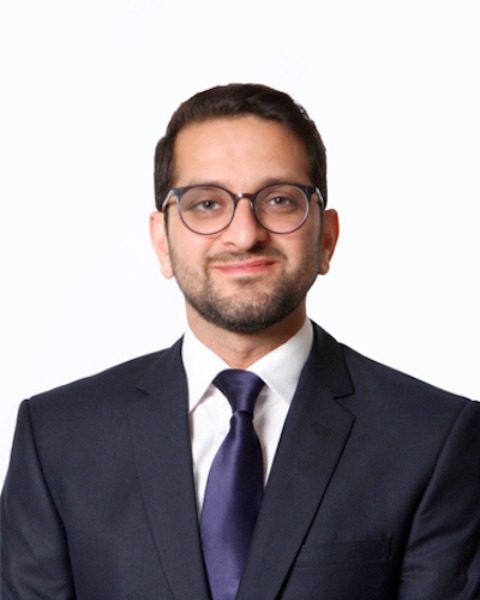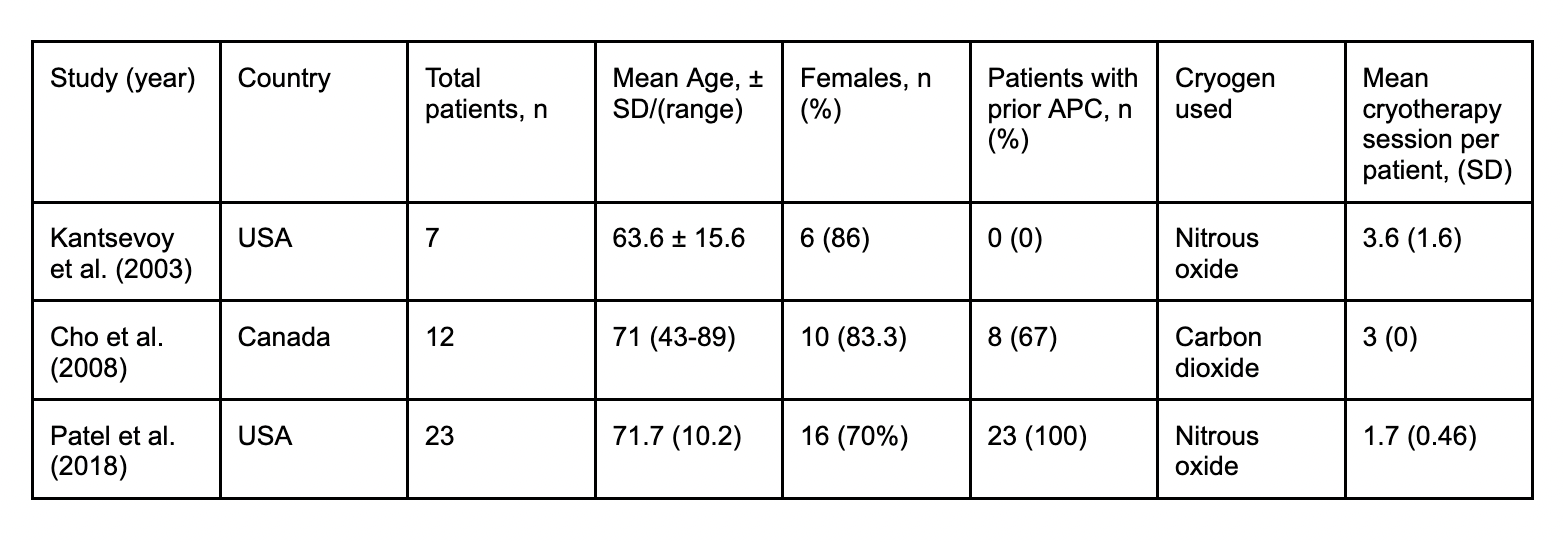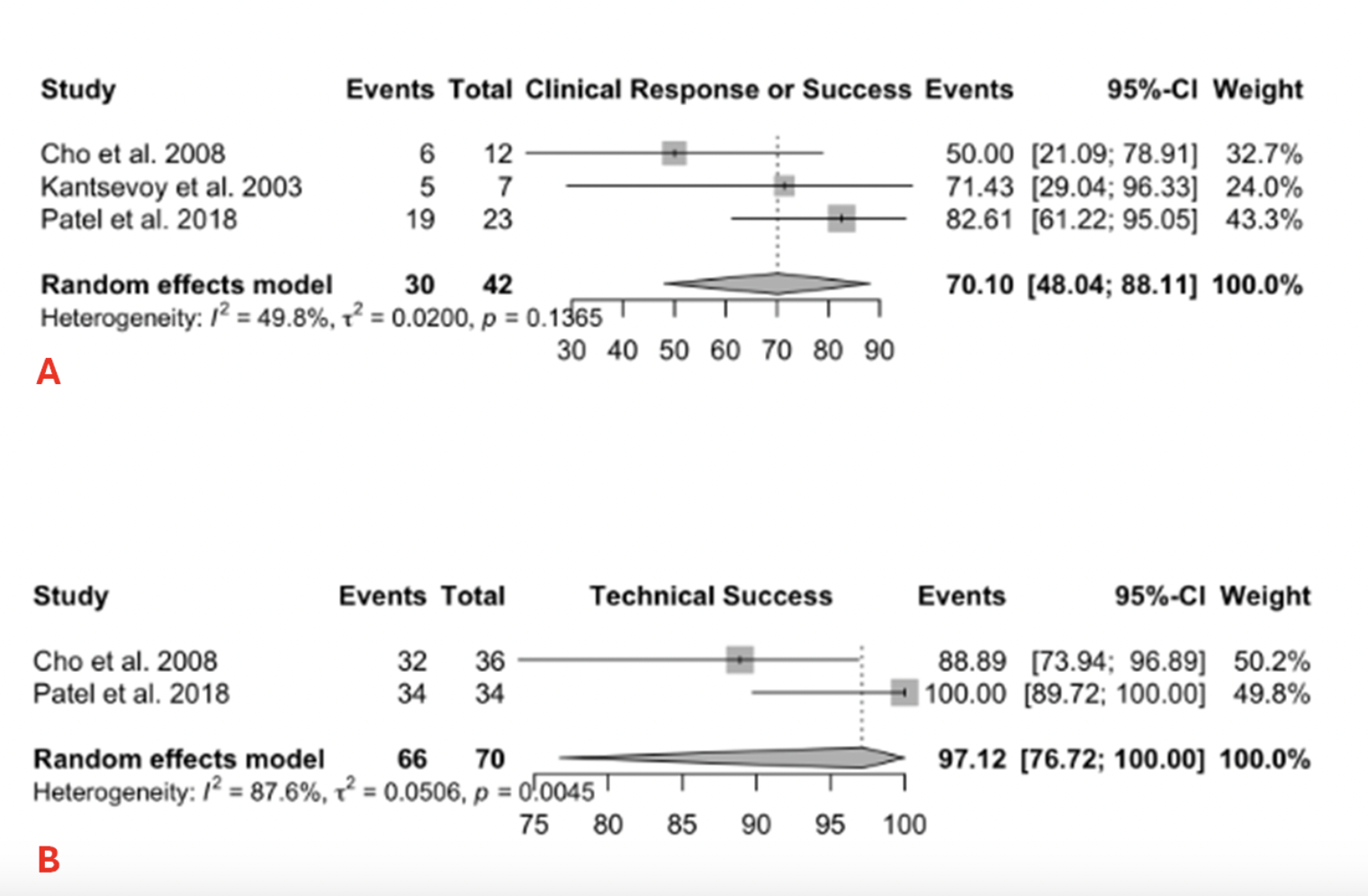Tuesday Poster Session
Category: GI Bleeding
P5200 - Efficacy and Safety of Endoscopic Cryotherapy for the Management of Gastric Antral Vascular Ectasia: A Systematic Review and Meta-Analysis
Tuesday, October 28, 2025
10:30 AM - 4:00 PM PDT
Location: Exhibit Hall

Nihal Ijaz I. Khan, MD
AdventHealth Orlando
Orlando, FL
Presenting Author(s)
Nihal I. Khan, MD1, Abdullah Javed, MBBS2, Saurabh Chandan, MD3, Syed Hamaad Rahman, DO4, Nouman Shafique, MD1, Abdul Mohammed, MD5, Jeevin Singh Sandhu, DO4, Babu P. Mohan, MD6
1AdventHealth Orlando, Orlando, FL; 2Allama Iqbal Medical College, Lahore, Punjab, Pakistan; 3Center for Advanced Therapeutic (CATE), Centura Health, Porter Adventist Hospital, Peak Gastroenterology, Orlando, FL; 4Methodist Dallas Medical Center, Dallas, TX; 5Department of Gastroenterology and Hepatology, AdventHealth Orlando, Orlando, FL; 6Orlando Gastroenterology PA, Orlando, FL
Introduction: Gastric antral vascular ectasia (GAVE) is often associated with chronic blood loss leading to iron deficiency anemia and frequent transfusion requirements. Argon plasma coagulation (APC) and endoscopic band ligation are treatment options. However, recurrence and treatment resistance are common, prompting the need for alternative strategies. Endoscopic cryotherapy, which involves the application of a cryogen to ablate GAVE, has shown promise in such refractory cases.
Methods: We systematically searched MEDLINE, EMBASE, and Scopus from inception through May 2025 for studies evaluating endoscopic cryotherapy in GAVE. Primary outcomes were clinical response/success and technical success. A random-effects model was used for pooled estimates, and heterogeneity was assessed using the I² statistic.
Results: Three studies involving 42 patients were included—two prospective pilot studies and one retrospective cohort. Nitrous oxide cryogen was used in two studies and carbon dioxide in one. Of the included patients, 31 had prior APC treatment. The mean age of patients ranged from 63.6 to 71.7 with 76% females. Baseline characteristics are summarized in Table 1.
The mean number of cryotherapy sessions per patient ranged from 1.7 to 3. Among two studies, the mean change in hemoglobin at study follow-up ranged from 1.3 to 2.6 g/d and mean number of blood transfusions per month after treatment ranged from 0.3 to 1.7. One cryotherapy related adverse event (self-limited abdominal pain) was observed across all three studies.
The pooled clinical success rate was 70.1% (95% CI, 48.0–88.1%; I² = 49.8%). The pooled technical success rate was 97.1% (95% CI, 76.7–100%; I² = 87.6%). Forest plots are shown in Figure 2.
Discussion: This meta-analysis demonstrates that endoscopic cryotherapy is an effective treatment option for GAVE, particularly in patients with incomplete response or recurrence after APC. Its high technical success and promising clinical outcomes support its use as a viable alternative in refractory cases. Larger, high-quality prospective studies are needed to validate these findings and to directly compare cryotherapy with other established treatment modalities to better inform clinical decision-making.

Figure: Table 1. Baseline patient and study characteristics

Figure: Figure 1. A: Forest plot of the pooled rate of clinical response or clinical success of endoscopic cryotherapy. B: Forest plot of the pooled rate of technical success of endoscopic cryotherapy.
Disclosures:
Nihal Khan indicated no relevant financial relationships.
Abdullah Javed indicated no relevant financial relationships.
Saurabh Chandan indicated no relevant financial relationships.
Syed Hamaad Rahman indicated no relevant financial relationships.
Nouman Shafique indicated no relevant financial relationships.
Abdul Mohammed indicated no relevant financial relationships.
Jeevin Singh Sandhu indicated no relevant financial relationships.
Babu Mohan indicated no relevant financial relationships.
Nihal I. Khan, MD1, Abdullah Javed, MBBS2, Saurabh Chandan, MD3, Syed Hamaad Rahman, DO4, Nouman Shafique, MD1, Abdul Mohammed, MD5, Jeevin Singh Sandhu, DO4, Babu P. Mohan, MD6. P5200 - Efficacy and Safety of Endoscopic Cryotherapy for the Management of Gastric Antral Vascular Ectasia: A Systematic Review and Meta-Analysis, ACG 2025 Annual Scientific Meeting Abstracts. Phoenix, AZ: American College of Gastroenterology.
1AdventHealth Orlando, Orlando, FL; 2Allama Iqbal Medical College, Lahore, Punjab, Pakistan; 3Center for Advanced Therapeutic (CATE), Centura Health, Porter Adventist Hospital, Peak Gastroenterology, Orlando, FL; 4Methodist Dallas Medical Center, Dallas, TX; 5Department of Gastroenterology and Hepatology, AdventHealth Orlando, Orlando, FL; 6Orlando Gastroenterology PA, Orlando, FL
Introduction: Gastric antral vascular ectasia (GAVE) is often associated with chronic blood loss leading to iron deficiency anemia and frequent transfusion requirements. Argon plasma coagulation (APC) and endoscopic band ligation are treatment options. However, recurrence and treatment resistance are common, prompting the need for alternative strategies. Endoscopic cryotherapy, which involves the application of a cryogen to ablate GAVE, has shown promise in such refractory cases.
Methods: We systematically searched MEDLINE, EMBASE, and Scopus from inception through May 2025 for studies evaluating endoscopic cryotherapy in GAVE. Primary outcomes were clinical response/success and technical success. A random-effects model was used for pooled estimates, and heterogeneity was assessed using the I² statistic.
Results: Three studies involving 42 patients were included—two prospective pilot studies and one retrospective cohort. Nitrous oxide cryogen was used in two studies and carbon dioxide in one. Of the included patients, 31 had prior APC treatment. The mean age of patients ranged from 63.6 to 71.7 with 76% females. Baseline characteristics are summarized in Table 1.
The mean number of cryotherapy sessions per patient ranged from 1.7 to 3. Among two studies, the mean change in hemoglobin at study follow-up ranged from 1.3 to 2.6 g/d and mean number of blood transfusions per month after treatment ranged from 0.3 to 1.7. One cryotherapy related adverse event (self-limited abdominal pain) was observed across all three studies.
The pooled clinical success rate was 70.1% (95% CI, 48.0–88.1%; I² = 49.8%). The pooled technical success rate was 97.1% (95% CI, 76.7–100%; I² = 87.6%). Forest plots are shown in Figure 2.
Discussion: This meta-analysis demonstrates that endoscopic cryotherapy is an effective treatment option for GAVE, particularly in patients with incomplete response or recurrence after APC. Its high technical success and promising clinical outcomes support its use as a viable alternative in refractory cases. Larger, high-quality prospective studies are needed to validate these findings and to directly compare cryotherapy with other established treatment modalities to better inform clinical decision-making.

Figure: Table 1. Baseline patient and study characteristics

Figure: Figure 1. A: Forest plot of the pooled rate of clinical response or clinical success of endoscopic cryotherapy. B: Forest plot of the pooled rate of technical success of endoscopic cryotherapy.
Disclosures:
Nihal Khan indicated no relevant financial relationships.
Abdullah Javed indicated no relevant financial relationships.
Saurabh Chandan indicated no relevant financial relationships.
Syed Hamaad Rahman indicated no relevant financial relationships.
Nouman Shafique indicated no relevant financial relationships.
Abdul Mohammed indicated no relevant financial relationships.
Jeevin Singh Sandhu indicated no relevant financial relationships.
Babu Mohan indicated no relevant financial relationships.
Nihal I. Khan, MD1, Abdullah Javed, MBBS2, Saurabh Chandan, MD3, Syed Hamaad Rahman, DO4, Nouman Shafique, MD1, Abdul Mohammed, MD5, Jeevin Singh Sandhu, DO4, Babu P. Mohan, MD6. P5200 - Efficacy and Safety of Endoscopic Cryotherapy for the Management of Gastric Antral Vascular Ectasia: A Systematic Review and Meta-Analysis, ACG 2025 Annual Scientific Meeting Abstracts. Phoenix, AZ: American College of Gastroenterology.
